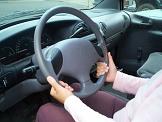Good steering techniques while steering a car
makes a smoother drive.

Good steering techniques
when steering a car:
Keep your hands low on the steering wheel
(at 8 and 4 or at 9 and 3).
This will keep your hands away from the airbag, so they wont break your nose in a collision.

It also keeps your arms in a more rested position.
Turn the steering wheel as little as necessary.
This will make for a smoother, less jerky ride in curves
and you won't drift too far left or right while steering a car.
Keep at least one hand on the steering wheel even when stopped.
You want to be ready to take control of your vehicle in any emergency situation. It's easy to want to give your hands a rest at a stop light and put them on your lap. But someone could hit you from the side or behind. be prepared for the unexpected!
Wrong steering techniques
This could break your wrist in a collision.
It's best to keep your hands on the outside
of the steering wheel.



You have no grip on the steering wheel
when steering a car with your palm flat.
This makes it much easier to lose control.
Good turning techniques
Generally the ideal speed at the apex of a right turn is 10-15 MPH.
The ideal speed in the middle of a left turn is usually 15-20 MPH.
The ideal turn speed will vary depending on the width of the road, degree of the turn and weather conditions, but the speeds stated above will be accurate about 85-90% of the time.

Look over your right shoulder for bikes on a right turn
Cyclists come fast if they are to the right of you, and it will be difficult for them to slow down if they hadn't started braking before the intersection.
You will likely be at fault if you hit a cyclist while turning.
Watch for pedestrians before a turn
Pedestrians are hardest to see on the right corner on a right turn, and on the left corner turning left from a one way street.
Look to out your left or right window for people coming into the crosswalk.
Look down then up
Do you have trouble coming in the center of your lane on turns, even going at the correct speed?
On a right turn after checking for peds and bikes, quickly glance down at the right line or curb then up into your lane. that will put you in the center of the new lane.
On a left turn, glance at the middle line, then up at the new road. ( Of course it would be the opposite if you drive in a country where you drive on the left side of the road.)
*If you tend to cut the corners too close on turns, then glance down at the far side of the new lane, then up. (left side on right turns, right side on left turns.)
You will go where your eyes are looking even out of a turn.
Brake before your turn
coming in slow before a turn gives you the best control when turning.
Coming too fast into a turn will cause you to under steer, bringing your car towards the lane of oncoming traffic.
coast into your turn
Coasting in the middle of your turn keeps your momentum through the turn without too much speed.
use a little speed out of your turn
A little speed (usually with the gas pedal), out of a turn keeps you from losing momentum.
It helps you know where to steer to get your car straight.
It also prevents you from being hit from someone following too close behind you.
top of page




